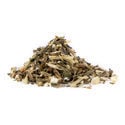Wild Dagga | Leonotis leonurus
Wild Dagga is another member of the vast catalogue of psychoactive herbs found on earth. The African plant is reported to have a similar high to that of cannabis, yet much less potent. The dried herb can be smoked or used to make decoctions.
| Buy 3 units | 5% Discount |
| Buy 5 units | 10% Discount |
| Buy 10 units | 15% Discount |
Wild Dagga: A Mild Psychoactive Herb
There appears to be an innate behaviour in humans to seek out and ingest consciousness-altering plants, and we happen to have access to an astonishing array of them—one of which is wild dagga.
Known by its scientific name Leonotis leonurus, wild dagga is a plant native to Southern Africa that has been compared to cannabis due to the effects it produces when smoked.
DESCRIPTION AND ECOLOGY
Wild dagga is found in abundance in its native habitat of damp grasslands. Specimens can grow up to 2m vertically and around 1m in width. The plant has been recognised for its attractive aesthetics, and is sometimes found fulfilling the role of an ornamental plant, boasting bright orange blossoms and a spiky crown.
| Type | Loose-leaf tea |
|---|---|
| Weight | 5 gr |
More information related to this product:
Una interesante suave planta
Quería pedir flores realmente escuché que tienen un sabor más agradable, aunque también se puede usar como relleno o té y funciona muy bien, tiene un efecto suave perceptible, la pillaría de nuevo para infusiones, mezclarla con las flores de cola de león y otras plantas.
wualiät ist gut
ganz lecker
Nice chill
For sure I'll order once again!
Relax ma non troppo
Un po' più potente di una tisana rilassante e molto piacevole. Personalmente preferisco i fiori più "dolci" rispetto allo stretch
Leicht Chillig
Leichte Wirkung aber entspannend!
Very good
Not more to say, it works really great.
Taste is nice
Buon sapore
Buono
Mellow
I mix it will cannabis and as tea, good stuff definitely buy again.. thanks Zamnesia team customer service is awesome.
Top
Ik rook dit als "wiet" en ik word er mild stoned van. Het afstamt ietwat van wiet namelijk. Fijn voor mij althans ik geen wiet meer rook i.v.m. hyperventilatie. Aan te raden voor wie hetzelfde probleem hebben.
Werkt goed
Beste ROA is voor mij in een wietpijp en zo telkens 3 a 5 dikke hijsen doen. Kan wat scherp in de keel zijn maar zolang mogelijk inhouden werkt het beste. Smaakt ook wel precies als een (zeer) lichte wiet als je het zo gebruikt.
Please note: If your country is not on our approved shipping list, we’re unable to ship items to your region. For more information, check out the full list of approved locations here: Ordering & Shipping





 United States
United States















